Publications
Treatment attrition among racial and ethnic minority youth
Treatment attrition among racial and ethnic minority youth
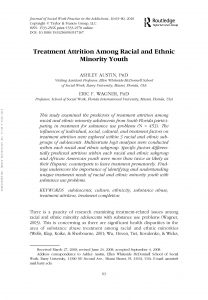 Abstract: This study examined the predictors of treatment attrition among racial and ethnic minority adolescents from South Florida participating in treatment for substance use problems (N= 453). The influences of individual, social, cultural, and treatment factors on treatment attrition were explored within 3 racial and ethnic subgroups of adolescents. Multivariate logit analyses were conducted within each racial and ethnic subgroup. Specific factors differentially predicted attrition within each racial and ethnic subgroup and African American youth were more than twice as likely as their Hispanic counterparts to leave treatment prematurely. Findings underscore the importance of identifying and understanding unique treatment needs of racial and ethnic minority youth with substance use problems.
Abstract: This study examined the predictors of treatment attrition among racial and ethnic minority adolescents from South Florida participating in treatment for substance use problems (N= 453). The influences of individual, social, cultural, and treatment factors on treatment attrition were explored within 3 racial and ethnic subgroups of adolescents. Multivariate logit analyses were conducted within each racial and ethnic subgroup. Specific factors differentially predicted attrition within each racial and ethnic subgroup and African American youth were more than twice as likely as their Hispanic counterparts to leave treatment prematurely. Findings underscore the importance of identifying and understanding unique treatment needs of racial and ethnic minority youth with substance use problems.
Austin, A., & Wagner, E.F. (2010). Treatment attrition among racial and ethnic minority youth. Journal of Social Work Practice in the Addictions, 10(1), 63-80. doi:10.1080/15332560903517167
Self-esteem and gender influence the response to risk information among alcohol using college students
Self-esteem and gender influence the response to risk information among alcohol using college students
 Abstract: Individuals with high self-esteem who engage in risky health behaviours often minimize the associated health risks; individuals with low self-esteem do not demonstrate such minimization. The influence of gender on health risk perceptions is less clear. This study examined the influences of gender and self-esteem upon college students’ responses to an alcohol risk message. Three-hundred-and-four alcohol-using college students read an NIAAA sponsored message regarding the risks associated with alcohol use. Results revealed that self-esteem and gender significantly and independently predicted alcohol-related attitudes, intentions, and follow-up behaviour. Females, especially those with low self-esteem, demonstrated greater alcohol-related concerns immediately after reading the message, while males exhibited more self-serving attitudes. In addition, high self-esteem participants and males reported fewer intentions to reduce drinking behaviour. At follow-up, higher self-esteem was associated with greater drinking frequency relative to lower self-esteem. Furthermore, males with higher self-esteem reported the greatest binge frequency compared with all other groups. These findings suggest that individuals with higher self-esteem and males are particularly resistant to information regarding the negative consequences of alcohol use.
Abstract: Individuals with high self-esteem who engage in risky health behaviours often minimize the associated health risks; individuals with low self-esteem do not demonstrate such minimization. The influence of gender on health risk perceptions is less clear. This study examined the influences of gender and self-esteem upon college students’ responses to an alcohol risk message. Three-hundred-and-four alcohol-using college students read an NIAAA sponsored message regarding the risks associated with alcohol use. Results revealed that self-esteem and gender significantly and independently predicted alcohol-related attitudes, intentions, and follow-up behaviour. Females, especially those with low self-esteem, demonstrated greater alcohol-related concerns immediately after reading the message, while males exhibited more self-serving attitudes. In addition, high self-esteem participants and males reported fewer intentions to reduce drinking behaviour. At follow-up, higher self-esteem was associated with greater drinking frequency relative to lower self-esteem. Furthermore, males with higher self-esteem reported the greatest binge frequency compared with all other groups. These findings suggest that individuals with higher self-esteem and males are particularly resistant to information regarding the negative consequences of alcohol use.
Neumann, C.A., Leffingwell, T.R., Wagner, E.F., Mignogna, J., & Mignogna, M. (2009). Self-esteem and gender influence the response to risk information among alcohol using college students. Journal of Substance Use, 14(6), 353-363. doi:10.3109/14659890802654540
Improving treatment through research: Directing attention to the role of development in adolescent treatment success
Improving treatment through research: Directing attention to the role of development in adolescent treatment success
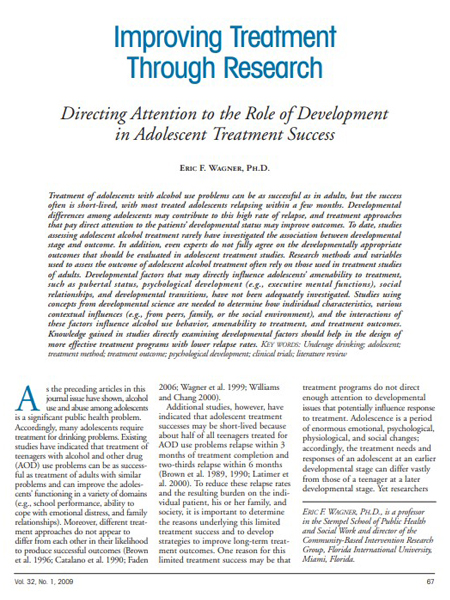 Abstract: Treatment of adolescents with alcohol use problems can be as successful as in adults, but the success often is short-lived, with most treated adolescents relapsing within a few months. Developmental differences among adolescents may contribute to this high rate of relapse, and treatment approaches that pay direct attention to the patients’ developmental status may improve outcomes. To date, studies assessing adolescent alcohol treatment rarely have investigated the association between developmental stage and outcome. In addition, even experts do not fully agree on the developmentally appropriate outcomes that should be evaluated in adolescent treatment studies. Research methods and variables used to assess the outcome of adolescent alcohol treatment often rely on those used in treatment studies of adults. Developmental factors that may directly influence adolescents’ amenability to treatment, such as pubertal status, psychological development (e.g., executive mental functions), social relationships, and developmental transitions, have not been adequately investigated. Studies using concepts from developmental science are needed to determine how individual characteristics, various contextual influences (e.g., from peers, family, or the social environment), and the interactions of these factors influence alcohol use behavior, amenability to treatment, and treatment outcomes. Knowledge gained in studies directly examining developmental factors should help in the design of more effective treatment programs with lower relapse rates.
Abstract: Treatment of adolescents with alcohol use problems can be as successful as in adults, but the success often is short-lived, with most treated adolescents relapsing within a few months. Developmental differences among adolescents may contribute to this high rate of relapse, and treatment approaches that pay direct attention to the patients’ developmental status may improve outcomes. To date, studies assessing adolescent alcohol treatment rarely have investigated the association between developmental stage and outcome. In addition, even experts do not fully agree on the developmentally appropriate outcomes that should be evaluated in adolescent treatment studies. Research methods and variables used to assess the outcome of adolescent alcohol treatment often rely on those used in treatment studies of adults. Developmental factors that may directly influence adolescents’ amenability to treatment, such as pubertal status, psychological development (e.g., executive mental functions), social relationships, and developmental transitions, have not been adequately investigated. Studies using concepts from developmental science are needed to determine how individual characteristics, various contextual influences (e.g., from peers, family, or the social environment), and the interactions of these factors influence alcohol use behavior, amenability to treatment, and treatment outcomes. Knowledge gained in studies directly examining developmental factors should help in the design of more effective treatment programs with lower relapse rates.
Wagner, E.F. (2009). Improving treatment through research directing attention to the role of development in adolescent treatment success. Alcohol Research & Health: The Journal of the National Institute on Alcohol Abuse and Alcoholism, 32(1), 67-75.
Psychiatric symptom patterns, proximal risk factors, and sexual risk behaviors among youth in outpatient substance abuse treatment
Psychiatric symptom patterns, proximal risk factors, and sexual risk behaviors among youth in outpatient substance abuse treatment
 Abstract: The purpose of the current study was to classify adolescents receiving outpatient treatment for alcohol or other drug (AOD) problems via self-reports of the Diagnostic and Statistical Manual of Mental Disorders (4th ed. American Psychiatric Association, 1994) psychiatric symptoms, and to identify group differences in measures of proximal risk factors for sexual risk behaviors (SRBs) and self-reported SRBs. Structured interviews were administered to 300 adolescent clients (202 males, 98 females; M = 16.22 years; SD = 1.13) receiving treatment services as part of a larger National Institute on Alcohol Abuse and Alcoholism (NIAAA)-funded randomized clinical trial. Ward’s method cluster analysis (Ward, 1963) was used to classify adolescents into distinct groups based on psychiatric symptom profiles. A multivariate analysis of variance was used to identify significant between-cluster differences in self-reported SRBs and proximal risk factors for SRB. Substantial heterogeneity in patterns of psychiatric symptoms was documented in this treatment sample. Membership in certain psychiatric symptom clusters was associated with several self-reported SRBs and correlated proximal risk factors. Among youth receiving AOD treatment, interventions to promote HIV/STI risk reduction may need adaptation for those with differing psychiatric profiles.
Abstract: The purpose of the current study was to classify adolescents receiving outpatient treatment for alcohol or other drug (AOD) problems via self-reports of the Diagnostic and Statistical Manual of Mental Disorders (4th ed. American Psychiatric Association, 1994) psychiatric symptoms, and to identify group differences in measures of proximal risk factors for sexual risk behaviors (SRBs) and self-reported SRBs. Structured interviews were administered to 300 adolescent clients (202 males, 98 females; M = 16.22 years; SD = 1.13) receiving treatment services as part of a larger National Institute on Alcohol Abuse and Alcoholism (NIAAA)-funded randomized clinical trial. Ward’s method cluster analysis (Ward, 1963) was used to classify adolescents into distinct groups based on psychiatric symptom profiles. A multivariate analysis of variance was used to identify significant between-cluster differences in self-reported SRBs and proximal risk factors for SRB. Substantial heterogeneity in patterns of psychiatric symptoms was documented in this treatment sample. Membership in certain psychiatric symptom clusters was associated with several self-reported SRBs and correlated proximal risk factors. Among youth receiving AOD treatment, interventions to promote HIV/STI risk reduction may need adaptation for those with differing psychiatric profiles.
Oshri, A., Tubman, J.G., Wagner, E.F., Leon-Morris, S., & Snyders, J. (2008). Psychiatric symptom patterns, proximal risk factors, and sexual risk behaviors among youth in outpatient substance abuse treatment. American Journal of Orthopsychiatry, 78(4), 430-441. doi:10.1037/a0014326
Empowering lesbian, gay, bisexual, and transgender youth: Lessons learned from a Safe Schools Summit
Empowering lesbian, gay, bisexual, and transgender youth: Lessons learned from a Safe Schools Summit
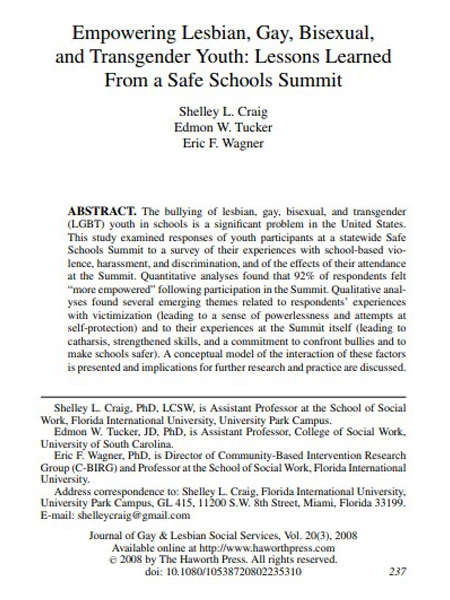 Abstract: The bullying of lesbian, gay, bisexual, and transgender (LGBT) youth in schools is a significant problem in the United States. This study examined responses of youth participants at a statewide Safe Schools Summit to a survey of their experiences with school-based violence, harassment, and discrimination, and of the effects of their attendance at the Summit. Quantitative analyses found that 92% of respondents felt “more empowered” following participation in the Summit. Qualitative analyses found several emerging themes related to respondents’ experiences with victimization (leading to a sense of powerlessness and attempts at self-protection) and to their experiences at the Summit itself (leading to catharsis, strengthened skills, and a commitment to confront bullies and to make schools safer). A conceptual model of the interaction of these factors is presented and implications for further research and practice are discussed.
Abstract: The bullying of lesbian, gay, bisexual, and transgender (LGBT) youth in schools is a significant problem in the United States. This study examined responses of youth participants at a statewide Safe Schools Summit to a survey of their experiences with school-based violence, harassment, and discrimination, and of the effects of their attendance at the Summit. Quantitative analyses found that 92% of respondents felt “more empowered” following participation in the Summit. Qualitative analyses found several emerging themes related to respondents’ experiences with victimization (leading to a sense of powerlessness and attempts at self-protection) and to their experiences at the Summit itself (leading to catharsis, strengthened skills, and a commitment to confront bullies and to make schools safer). A conceptual model of the interaction of these factors is presented and implications for further research and practice are discussed.
Craig, S.L., Tucker, E.W., & Wagner, E.F. (2008). Empowering lesbian, gay, bisexual, and transgender youth: Lessons learned from a Safe Schools Summit. Journal of Gay & Lesbian Social Services, 20(3), 237-252. doi:10.1080/10538720802235310
Exploding stereotypes and moving forward: LGBT research has a new look
Exploding stereotypes and moving forward: LGBT research has a new look
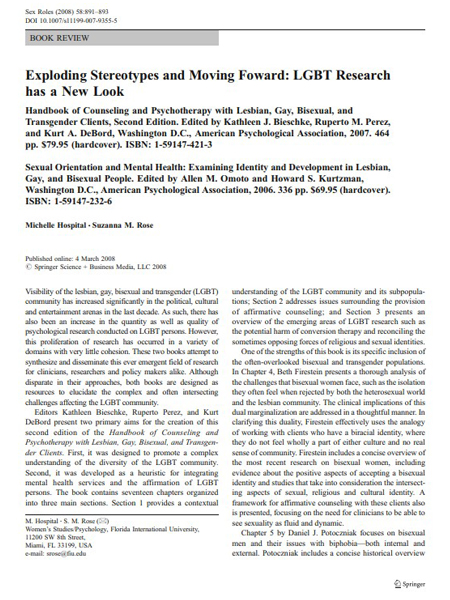 Abstract: The article reviews the books “Handbook of Counseling and Psychotherapy with Lesbian, Gay, Bisexual, and Transgender Clients,” second edition, edited by Kathleen J. Bieschke, Ruperto M. Perez and Kurt A. DeBord and “Sexual Orientation and Mental Health: Examining Identity and Development in Lesbian, Gay, and Bisexual People,” edited by Allen M. Omoto and Howard S. Kurtzman.
Abstract: The article reviews the books “Handbook of Counseling and Psychotherapy with Lesbian, Gay, Bisexual, and Transgender Clients,” second edition, edited by Kathleen J. Bieschke, Ruperto M. Perez and Kurt A. DeBord and “Sexual Orientation and Mental Health: Examining Identity and Development in Lesbian, Gay, and Bisexual People,” edited by Allen M. Omoto and Howard S. Kurtzman.
Hospital, M., & Rose,S. (2008). Exploding stereotypes and moving forward: LGBT research has a new look. Sex Roles, 58(11-12), 891-893. doi:10.1007/s11199-007-9355-5
Developmentally informed research on the effectiveness of clinical trials: A primer for assessing how developmental issues may influence treatment responses among adolescents with alcohol use problems
Developmentally informed research on the effectiveness of clinical trials: A primer for assessing how developmental issues may influence treatment responses among adolescents with alcohol use problems
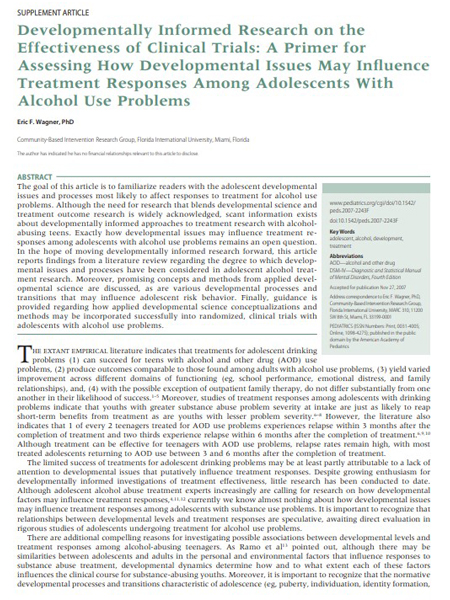 Abstract: The goal of this article is to familiarize readers with the adolescent developmental issues and processes most likely to affect responses to treatment for alcohol use problems. Although the need for research that blends developmental science and treatment outcome research is widely acknowledged, scant information exists about developmentally informed approaches to treatment research with alcohol-abusing teens. Exactly how developmental issues may influence treatment responses among adolescents with alcohol use problems remains an open question. In the hope of moving developmentally informed research forward, this article reports findings from a literature review regarding the degree to which developmental issues and processes have been considered in adolescent alcohol treatment research. Moreover, promising concepts and methods from applied developmental science are discussed, as are various developmental processes and transitions that may influence adolescent risk behavior. Finally, guidance is provided regarding how applied developmental science conceptualizations and methods may be incorporated successfully into randomized, clinical trials with adolescents with alcohol use problems.
Abstract: The goal of this article is to familiarize readers with the adolescent developmental issues and processes most likely to affect responses to treatment for alcohol use problems. Although the need for research that blends developmental science and treatment outcome research is widely acknowledged, scant information exists about developmentally informed approaches to treatment research with alcohol-abusing teens. Exactly how developmental issues may influence treatment responses among adolescents with alcohol use problems remains an open question. In the hope of moving developmentally informed research forward, this article reports findings from a literature review regarding the degree to which developmental issues and processes have been considered in adolescent alcohol treatment research. Moreover, promising concepts and methods from applied developmental science are discussed, as are various developmental processes and transitions that may influence adolescent risk behavior. Finally, guidance is provided regarding how applied developmental science conceptualizations and methods may be incorporated successfully into randomized, clinical trials with adolescents with alcohol use problems.
Wagner, E.F. (2008). Developmentally informed research on the effectiveness of clinical trials: A primer for assessing how developmental issues may influence treatment responses among adolescents with alcohol use problems. Pediatrics, 121:S337-S347. doi:10.1542/peds.2007-2243F
Predictors of retention in an alternative-to-prison substance abuse treatment program
Predictors of retention in an alternative-to-prison substance abuse treatment program
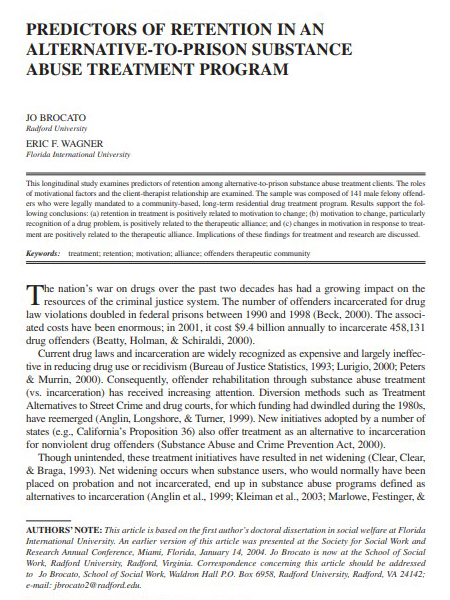 Abstract: This longitudinal study examines predictors of retention among alternative-to-prison substance abuse treatment clients. The roles of motivational factors and the client-therapist relationship are examined. The sample was composed of 141 male felony offenders who were legally mandated to a community-based, long-term residential drug treatment program. Results support the following conclusions: (a) retention in treatment is positively related to motivation to change; (b) motivation to change, particularly recognition of a drug problem, is positively related to the therapeutic alliance; and (c) changes in motivation in response to treatment are positively related to the therapeutic alliance. Implications of these findings for treatment and research are discussed.
Abstract: This longitudinal study examines predictors of retention among alternative-to-prison substance abuse treatment clients. The roles of motivational factors and the client-therapist relationship are examined. The sample was composed of 141 male felony offenders who were legally mandated to a community-based, long-term residential drug treatment program. Results support the following conclusions: (a) retention in treatment is positively related to motivation to change; (b) motivation to change, particularly recognition of a drug problem, is positively related to the therapeutic alliance; and (c) changes in motivation in response to treatment are positively related to the therapeutic alliance. Implications of these findings for treatment and research are discussed.
Brocato, J., & Wagner, E.F. (2008). Predictors of retention in an alternative-to-prison substance abuse treatment program. Criminal Justice and Behavior, 35(1), 99-119. doi:10.25148/etd.fi14051844
Adolescent substance use: Developmental considerations
Use of brief interventions for drug abusing teenagers within a middle and high school setting
Use of brief interventions for drug abusing teenagers within a middle and high school setting
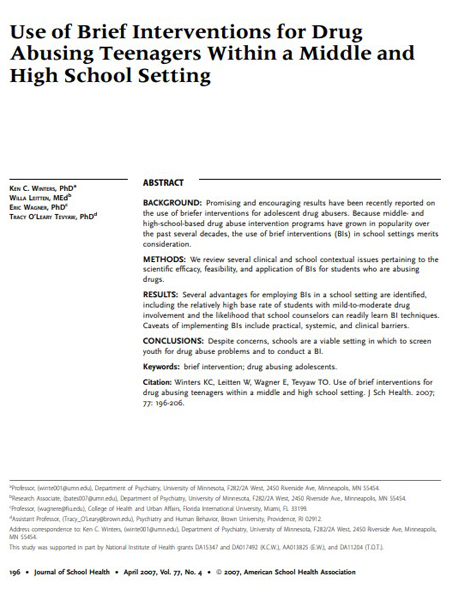 Abstract: Promising and encouraging results have been recently reported on the use of briefer interventions for adolescent drug abusers. Because middle- and high-school-based drug abuse intervention programs have grown in popularity over the past several decades, the use of brief interventions (BIs) in school settings merits consideration. We review several clinical and school contextual issues pertaining to the scientific efficacy, feasibility, and application of BIs for students who are abusing drugs. Several advantages for employing BIs in a school setting are identified, including the relatively high base rate of students with mild-to-moderate drug involvement and the likelihood that school counselors can readily learn BI techniques. Caveats of implementing BIs include practical, systemic, and clinical barriers. Despite concerns, schools are a viable setting in which to screen youth for drug abuse problems and to conduct a BI.
Abstract: Promising and encouraging results have been recently reported on the use of briefer interventions for adolescent drug abusers. Because middle- and high-school-based drug abuse intervention programs have grown in popularity over the past several decades, the use of brief interventions (BIs) in school settings merits consideration. We review several clinical and school contextual issues pertaining to the scientific efficacy, feasibility, and application of BIs for students who are abusing drugs. Several advantages for employing BIs in a school setting are identified, including the relatively high base rate of students with mild-to-moderate drug involvement and the likelihood that school counselors can readily learn BI techniques. Caveats of implementing BIs include practical, systemic, and clinical barriers. Despite concerns, schools are a viable setting in which to screen youth for drug abuse problems and to conduct a BI.
Winters, K.C., Leitten, W., Wagner, E., & O’Leary Tevyaw, T.(2007) Use of brief interventions for drug abusing teenagers within a middle and high school setting. Journal of School Health, 77(4), 196–206. doi:10.1111/j.1746-1561.2007.00191.x

